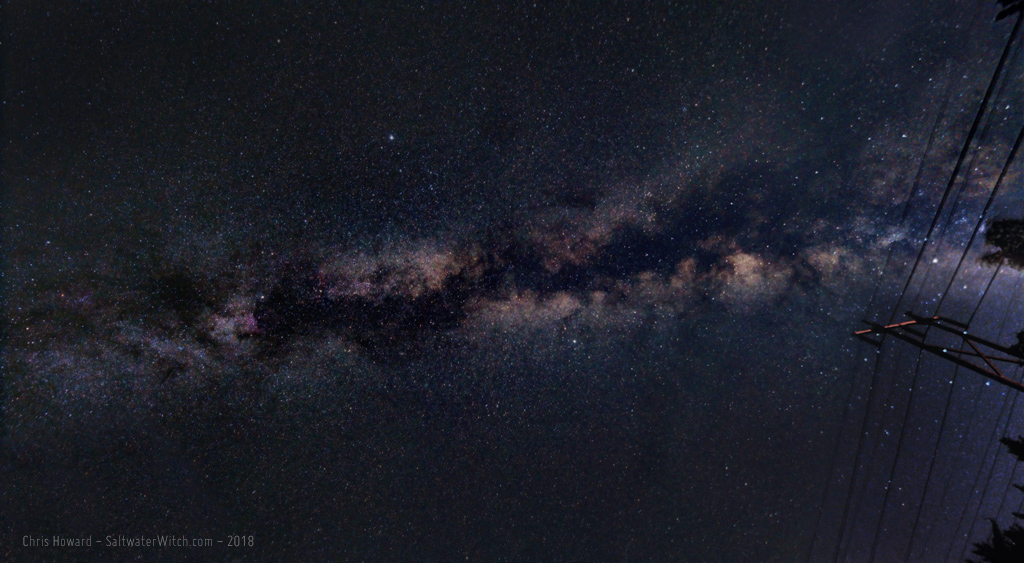Andromeda never gets old
Here it is in hydrogen-alpha, just the one narrowband slice of the spectrum. Andromeda Galaxy, Messier 31, is probably the first target for northern hemisphere astrophotographers--well, it's either M31 or M42 Orion Nebula. Both are intensely bright deep sky objects you can see without a telescope, given reasonably clear and dark skies. I have captured M31 more times than I can count. The galaxy stands out in the night sky when it swings around every year, making it an easy target. Galaxies are also great full spectrum targets for color cameras, DSLRs and mirrorless cameras, but that doesn't mean you can't pull some awesome data out of Andromeda in narrowband or infrared. I captured M31 in near-infrared (longpass 850nm) a couple years ago, and last night I captured our galactic neighbor in very narrow hydrogen-alpha (3nm Ha), and this stacked set of 42 sub-exposures highlights massive HII regions, mostly emission nebulae, along the outer spiral arms, with dense bands of dust and debris ringing the galactic core. This will make a great red channel in an RGB image, or I may go with HaRGB.
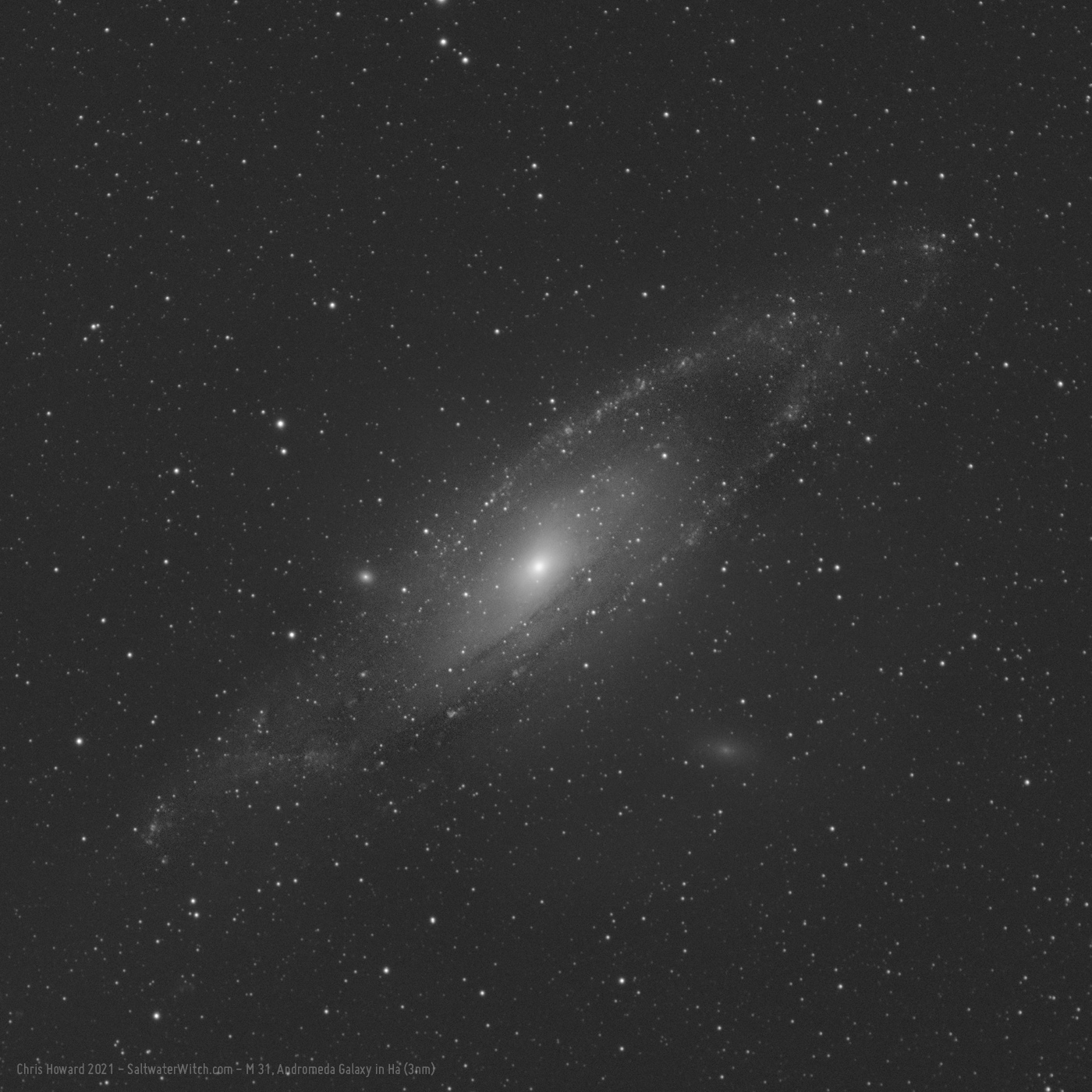
Posted October 8, 2021
Second night out with the Apertura 8" Newt
I selected IC 5146, the Cocoon Nebula as a nice broadband color target for my second clear night with the Newt, and at 800mm focal length, the Cocoon should fit nicely in the frame, with room for the long trail of dust flowing away from it--if I can manage it.
Mechanics: the stars only look slightly better tonight, still wacky around the edges. They were a coma-induced mess last night, but I rearranged some of the imaging train and...it looks, well, not much better. But I'll get there. I am not the type to spend all night twiddling with spacers and digital calipers to calculate the correct back-distance and eliminate every last trace of coma. I'd rather image, and make small corrections along the way, even if it means the stars look like crap before I get things properly dialed in.
So, I was also looking for a nice target to shoot while the Cocoon climbed a bit higher in the sky, more than 30°, and I went for NGC 6946, Caldwell 12, the Fireworks Galaxy in Cepheus. I don't normally go for galaxies, unless they're relatively close by, but there are a few like M101 (Pinwheel Galaxy) and M81 (Bode's Galaxy) which are great targets if you're running with less than a 1000mm--other than the obvious ones like M31, M33, LMC, etc.
The Fireworks Galaxy is 22 million lightyears away. To put that distance in perspective, one lightyear is almost 6 trillion miles. I'll leave the multiplying by 22 million up to you. Fireworks is a medium-sized galaxy, about half the size of the Milky Way at about 40,000 lightyears across. It's a spiral galaxy, and it has the advantage, from our perspective, of being face-on, or is that top-down? Notes: 31 x 120 second subs, no filters.
NGC 6946, Caldwell 12, the Fireworks Galaxy in Cepheus:
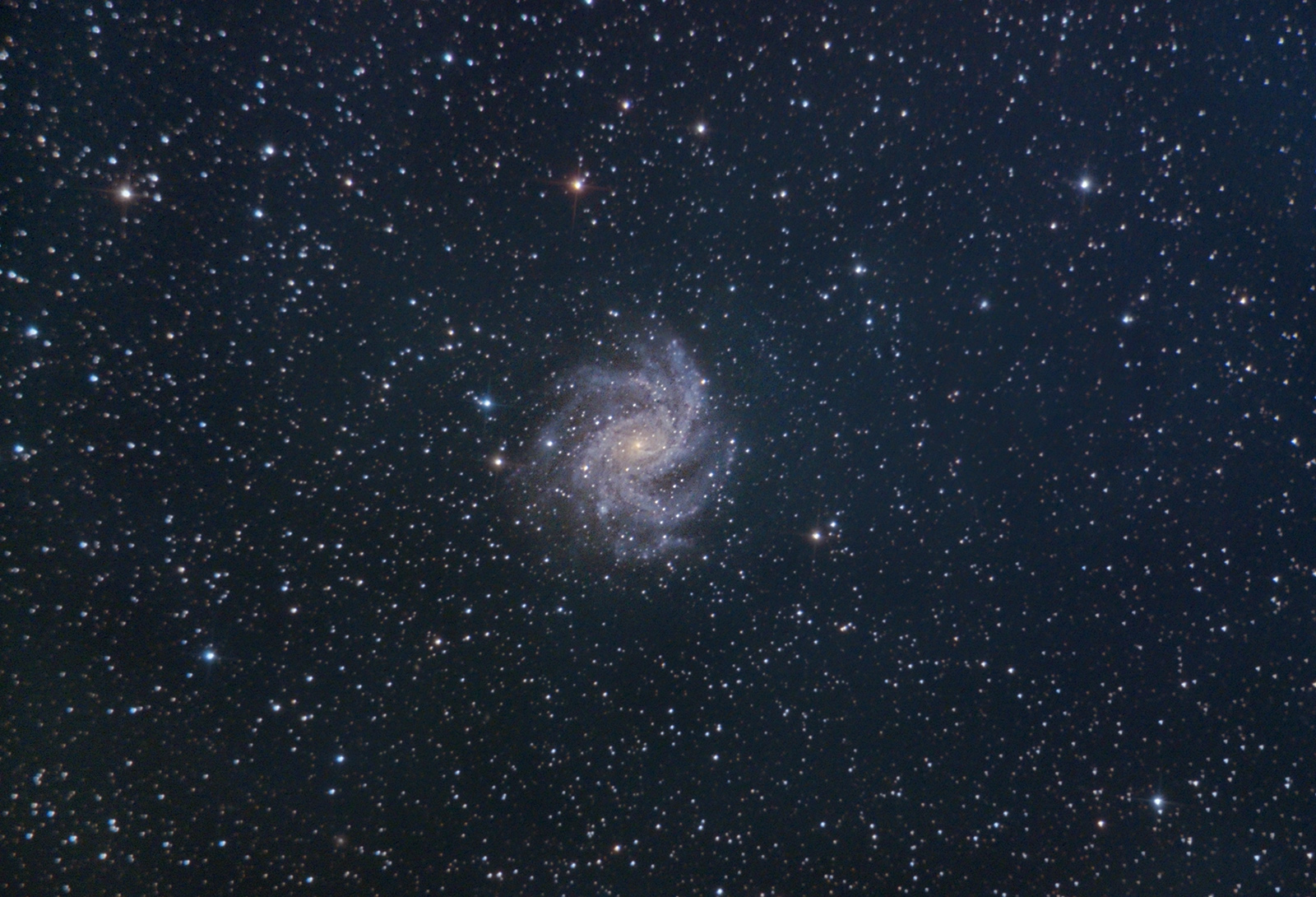
The Cocoon Nebula (IC 5146, Caldwell 19, Sh 2-125) is a roiling mix of new stars, ionized gases emitting light, mostly in wavelengths out at the hydrogen end of the spectrum, with additional layers of clouds of dust and gas lit up by those same stars. Actually, most of the ionizing weight appears to be carried by the central pre-main-sequence B type star, BD+46°3474. The whole circular structure labeled IC 5146 is a reflection nebula and an H ii region that forms a "cocoon" around BD+46°3474 (that bright star in the center), which is probably less than a 1 million years old and is probably closer to 100,000 years old (compare that to our star, the Sun, at 4.6 billion years old). This central star's intense radiation and stellar winds have hollowed out the dense molecular clouds, and the radiation flowing off it is ionizing the material and lighting it up. There's a long dark band of gas trailing off frame at the bottom of this image that leads to a separately identified dark nebula, Barnard 168 (B168). The Cocoon is around 2500 lightyears away in the constellation Cygnus. Imaging Notes: There's so much going on here across the visual spectrum right on out to hydrogen-alpha and near-infrared. Most color astro cameras, DSLRs, and mirrorless cameras will be able to pick it all up. If you can, light pollution allowing, try to catch the Cocoon Nebula without any extra filters. My imaging run: 67 x 240 second subs, no filters. Apertura 8 inch f/4 800m FL Imaging Newtonian, ZWO ASI071MC color camera, GSO Coma Corrector, SkyWatcher EQ6-R Pro mount, Stellarmate/Raspberry Pi 4 running INDI/Ekos/KStars.
IC 5146, the Cocoon Nebula in Cygnus:
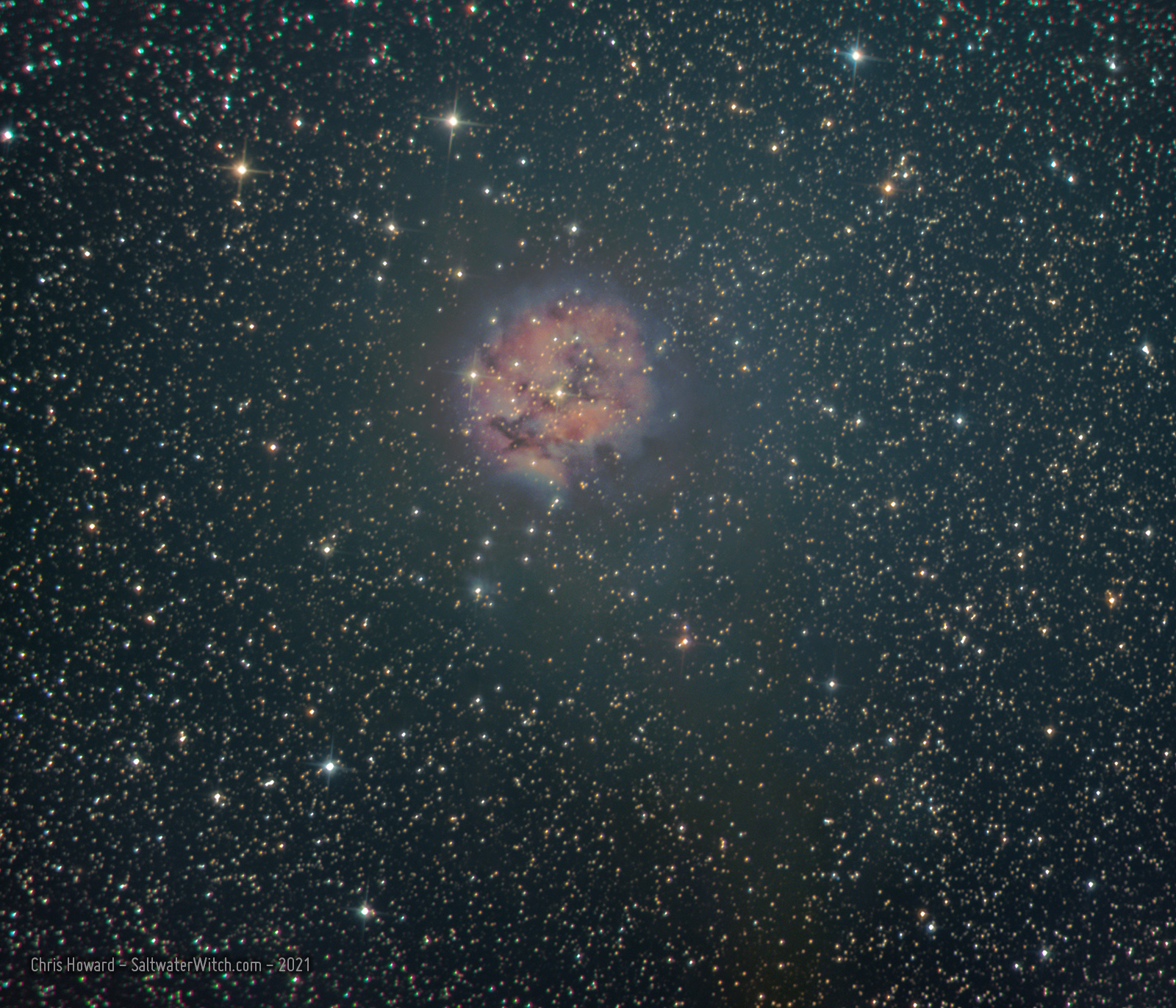
Posted June 18, 2021
The cool things you catch while testing
I haven't used the color rig this season, and I was capturing batches of subframes across the sky, mainly to test out focusing. I polar-aligned reasonably well, but didn't guide with these subs. I came away with a bunch of starfield shots, and stacked a couple batches.
The first is the massive blue-white B-type star in the center is Gamma Lyrae or Sulafat from the Arabic السلحفاة al-sulḥafāt "turtle", 漸台三 Jiāntāisān in Chinese astronomy, meaning the Third Star of Clepsydra Terrace. Sulafat is 15 times the sun's size, a little over 600 lightyears away, and it's burning brightly through its main sequence and out the other side.
What's cool is if you right-click this image, open in a new tab, and expand to full size, you can see M57, the Ring Nebula, is there in color middle top of the image.
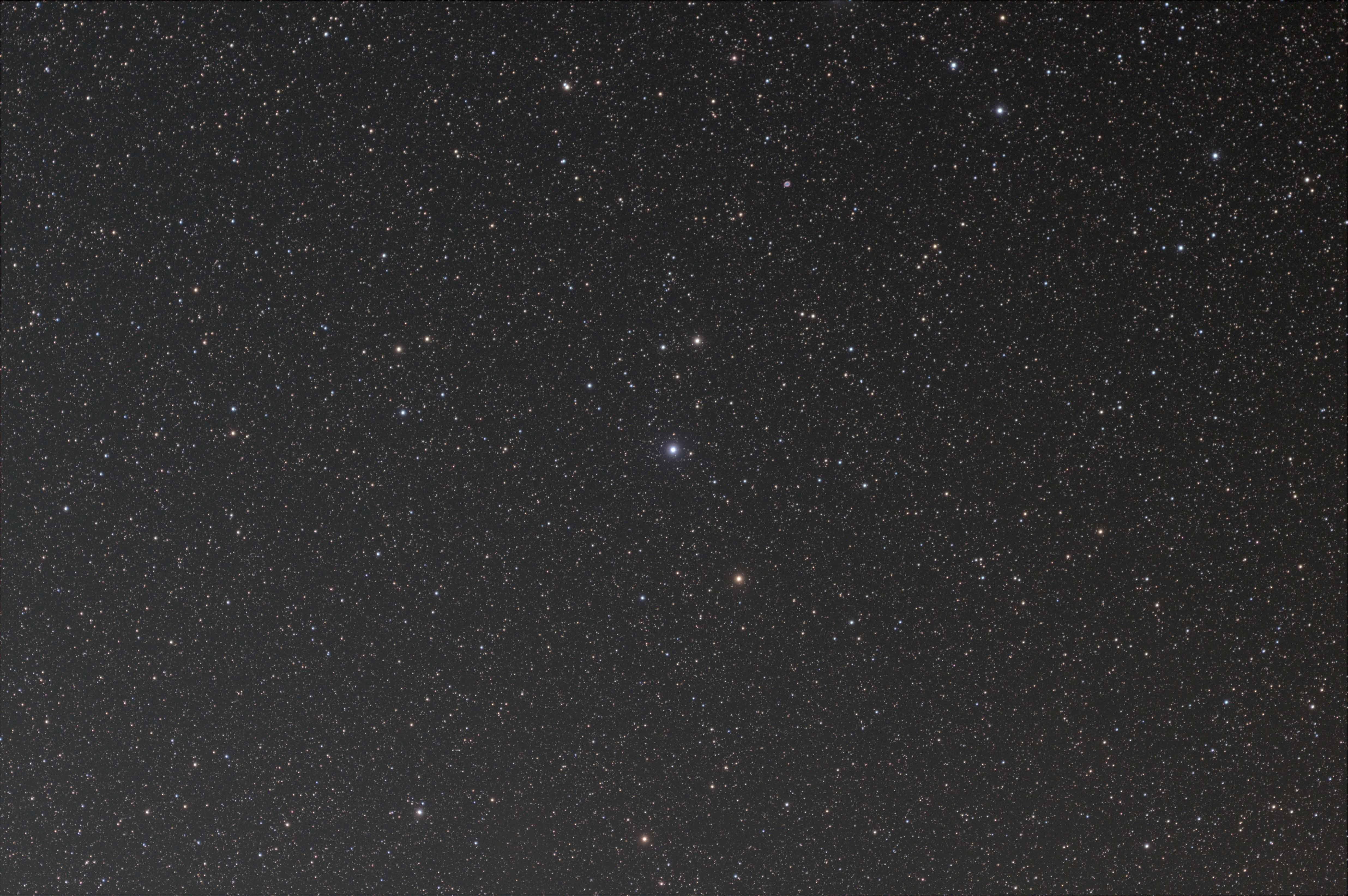
For this set of subs I centered on NGC 5746, the tiny sliver of a barred spiral galaxy in the center. The bright star below it is 109 Virginis in the constellation Virgo. What's crazy about this shot it there at least twenty other galaxies in this frame--probably a lot more that just show up as pinpoints of light.
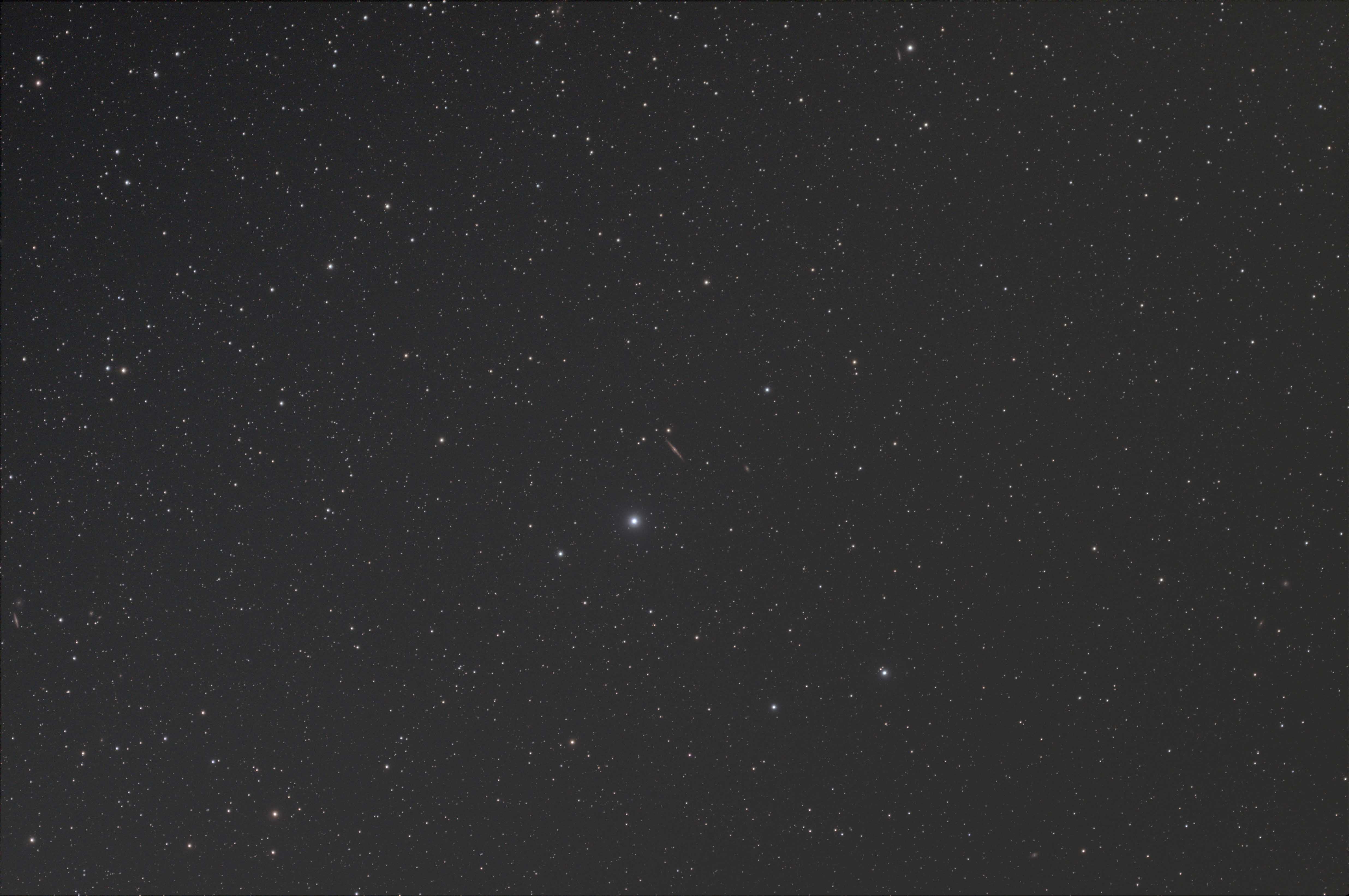
Posted May 14, 2021
M81 and M82
After the earth rotates Orion and Monoceros out of view in the south, I'm only left with a few nebulae. There are a bunch of galaxies though... But with the scope I'm using for large deep sky objects (William Optics GT81 with 392mm focal length), most are too small. M81 (Bode's Galaxy) and M82 (Cigar Galaxy) however, are just large enough to capture. This shot is made up of 30 x 60-second subs in Hydrogen-alpha, Green, and Blue filters that I've mapped to RGB. With the Ha filter you lose some of that broadband Red light, but the trade-off (better IMO) is you capture any large H2 regions in the galaxies. Those are the red and pink chunky bits in Bode's Galaxy and a lot more of that "starburst" core of the Cigar Galaxy—so, basically I'm capturing nebulae in someone else's galaxy, almost 12 million lightyears away from us. Cool. Both of these Messier Objects are in the Constellation Ursa Major (Big Dipper). Gear notes: SkyWatcher EQ6-R Pro mount, William Optics GT81 Apochromatic Refractor 392mm at f/4.7, ZWO ASI1600MM-Pro monochrome camera, Astronomik 6nm filters, Moonlite focuser, Raspberry Pi 4 4GB / 128GB running INDI/KStars/Ekos

Posted November 17, 2020
Andromeda from the Galactic Edge
Here's the Andromeda Galaxy (M31) without the stars and other clutter from our own galaxy in the way. I have processing tools that will algorithmically remove stars from an image, and it does a reasonable job. What I'm showing here is what Andromeda would look like if you could travel from our location on the Orion Spur (a minor branch off one of the Milky Way's spiral arms), pass through the Perseus Arm, to the edge of our galaxy, and then take some pics of M31. Our star, the Sun, sits in the middle of one side of our galaxy. We are so used to seeing a star field in astro images we do not realize all the stars we can see in the night sky--with our eyes, are in our own galaxy. Some of those pinpoints of light are galaxies themselves but are so far away they appear no different from stars to our eyes. In this image of M31 the two star-like objects above and below Andromeda are M110 (larger, below) and M32 (above). These two are actually satellite galaxies that orbit Andromeda. Yes, just as stars have planets, and planets have moons, large galaxies can capture other galaxies in their gravitational pull. Our galaxy, the Milky Way, has several in orbit, including the Large and Small Magellanic Clouds.
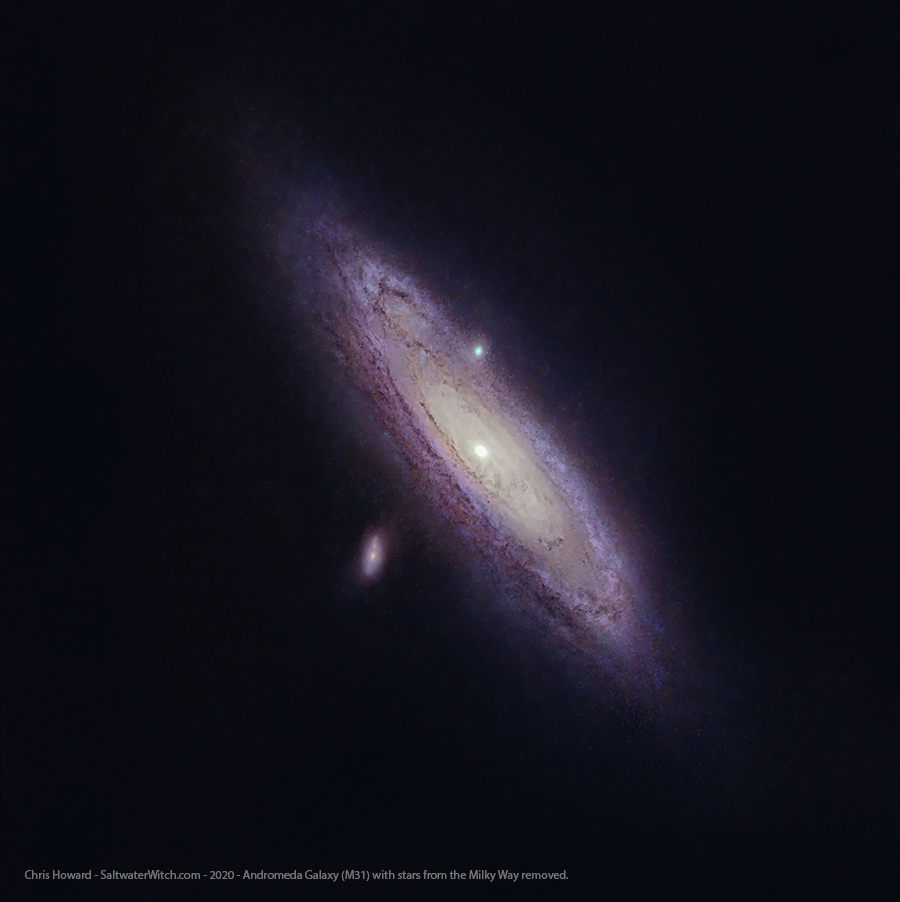
Posted April 28, 2020
Messing around with Messier in Infrared
We finally had several hours of clear night sky--not spectacular, but I'll take what I can get this time of year. That whole “April showers bring May flowers” thing really applies to this region of the planet. I think we’ve had four or five full clear nights in the last couple months--and I can’t remember multiple clear days in a row, but I am looking forward to more opportunities to capture the night skies soon--early summer through the winter.
One of the paths I’m currently on is to be more productive--in very concrete terms. I simply want to produce more imaging data per night than I have before. One way to do this is to upgrade equipment and pile on new devices, which translates into an EQ mount with more capacity and another scope and camera to double the exposure time. In other words, spend more money, which I don’t want to do.
Another option is to improve the efficiency of my current setup and systems. This is where I’m presently spending my time and effort, squeezing out 5-10 minutes per hour I was losing with slower hardware and application workflows (per image download times, auto-focus and plate-solving routines, etc). I will test out NINA (https://nighttime-imaging.eu) at some point, because I’ve heard great things about its speed. I’m currently using Sequence Generator Pro 3 with my narrowband refractor setup (William Optics GT81, Moonlite Focuser, ZWO ASI1600MM-Pro mono, and ASI120MM-Mini Guide-cam), and with a few exceptions and idiosyncrasies, which often turn out to be ASCOM or device-specific weirdness, not an SGP problem, things are going smoothly.
I have been working through a couple different configurations of equipment, automation systems, and application workflows, mostly focused on building a narrowband setup with two cables--USB3 and a single 12vdc 10 amp line. For now, I’m using Windows 10 on a fanless Celeron-based system, which easily handles the processing load during capture and plate-solving. On the scope itself I have the Moonlite Focuser controller, a powered USB 3 hub, and all power, environment, and dew control functions managed through a Pegasus Astro Pocket Powerbox.
I ran my first in-depth test of this system last night, jumping all over the sky east of the meridian, taking several 1-minute subs of M3, M10, M12, M13, M51, and NGC 6826 (blinking planetary nebula in Cygnus). I have to say, my impression of SGP has not changed. I already had a high opinion of it, and coming back to it for version 3 has been fun and exciting--and more importantly, productive. I was skipping all over the sky last night, pulling up the Framing and Mosaic wizard half a dozen times, and appending new targets to the sequence. I would have kept going after midnight, but the clouds rolled in and shut the show down.
Near-IR filter notes--something to consider if you’re guiding off-axis: I’m using Astronomik 1.25” narrowband filters (Ha, OIII, SII) in this ZWO EFW, but I also have an Optolong IR 685nm longpass filter installed in the 5th place. I ran into a slight issue with off-axis guiding because the IR filter’s focal offset with the Astronomik’s is so great that it throws off the focus of guide camera. I have to plan to do any near-IR exposures at the end of any sequence because this forces me to adjust the focus in PHD2 for the ZWO ASI120MM.
Here are a few shots from last night, using the Optolong 685nm longpass filter.
Whirlpool Galaxy (M51) in near-Infrared, WIlliam Optics GT81, ZWO ASI1600MM-Pro mono, 685nm Near-IR longpass filter. M51 is around 23 million lightyears away from us in the constellation Canes Venatici. It’s a tiny view of the galaxies, but I’m impressed with the trailing gas and dust that IR managed to capture.

M10 (NGC 6254) is a globular cluster of stars about 14,000 lightyears away in the constellation of Ophiuchus. 4 x 60 second subs in near-Infrared, William Optics GT81, ZWO ASI1600MM-Pro mono, 685nm Near-IR longpass filter. In IR the stars are really distinct in the cluster, and I want to come back with RGB and use the IR frames for luminance, and see how that looks.
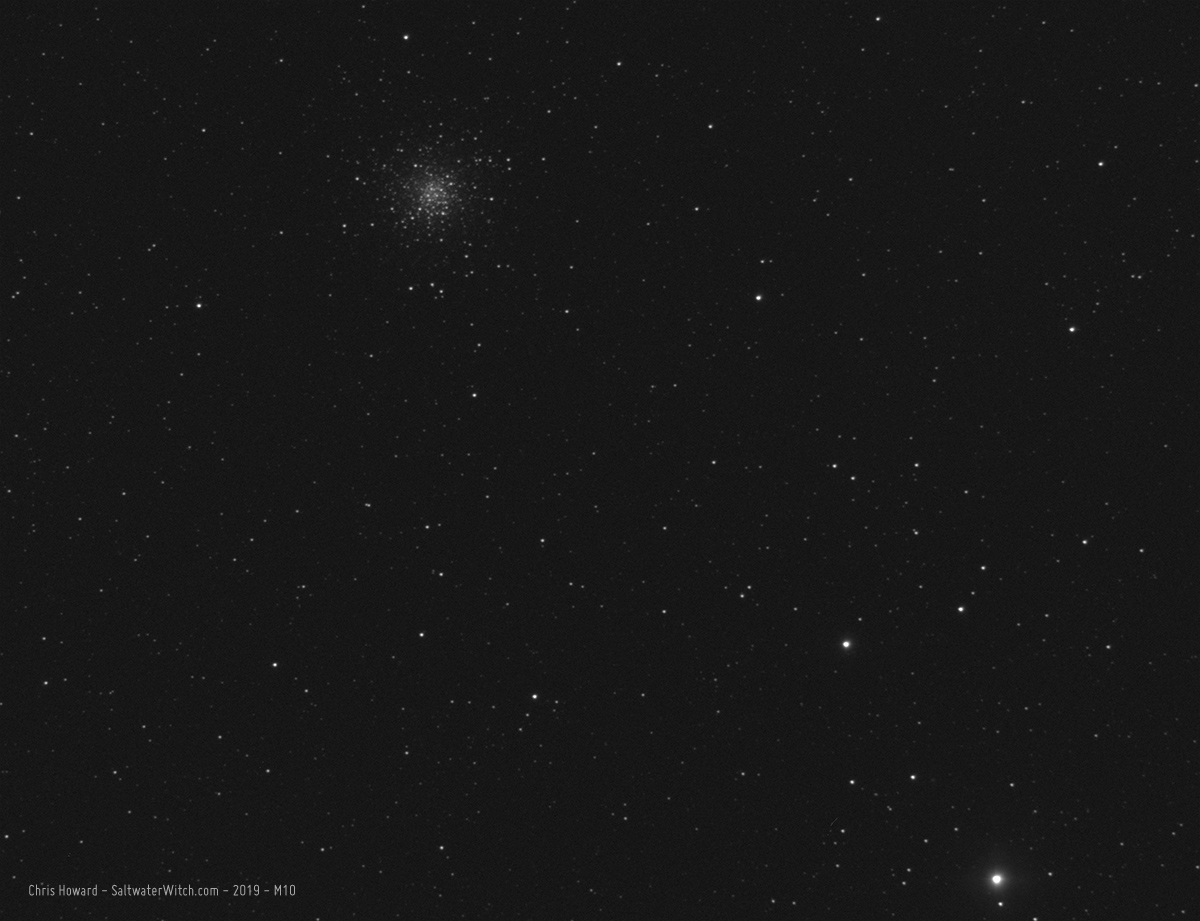
Messier 3 Cluster:
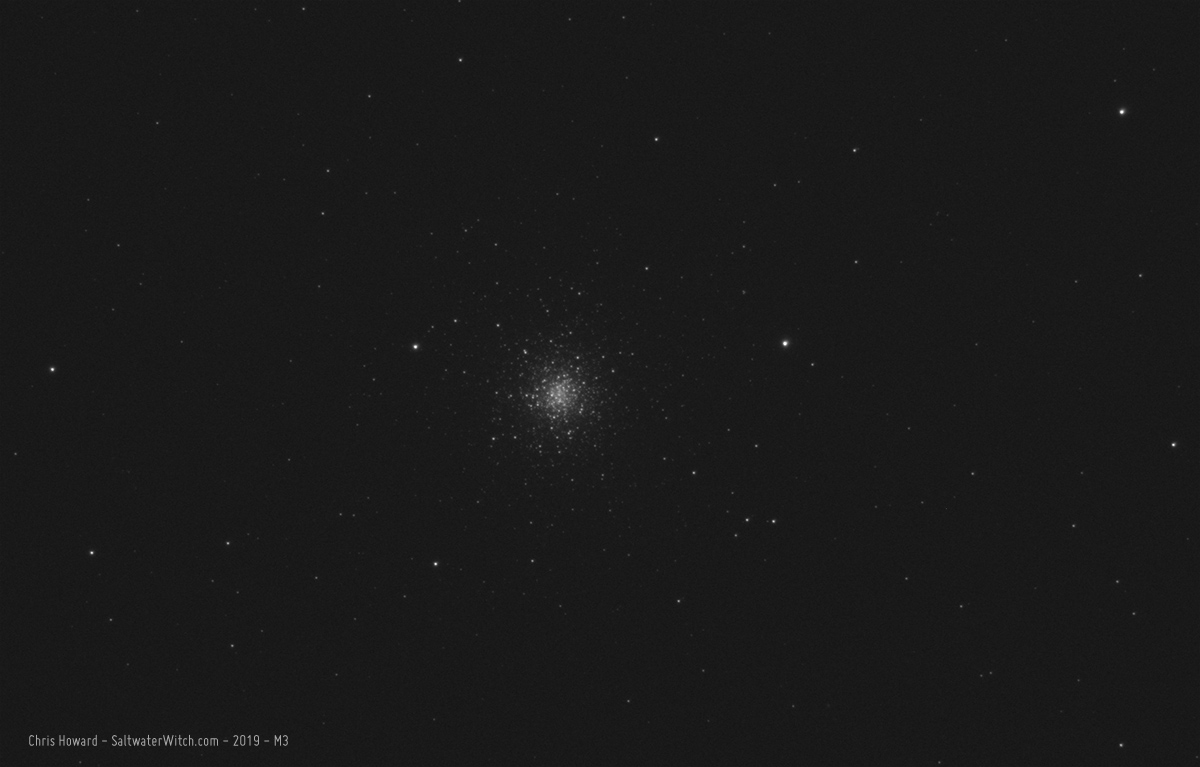
Messier 13 Cluster in Hercules:

Messier 13, Hercules Globular Cluster (also NGC 6205) - using the IR image as luminance with an old RGB version of M13:
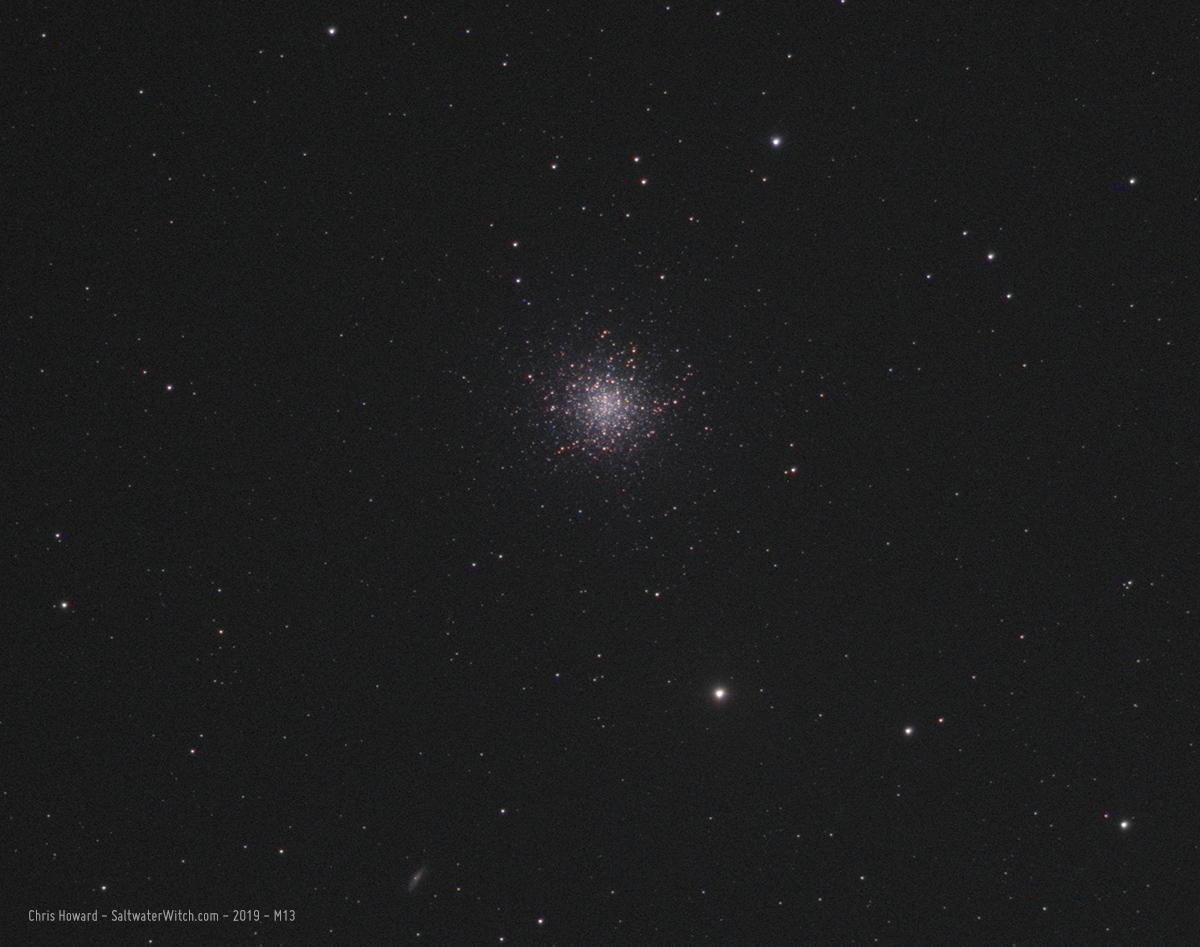
Messier 12 Cluster:
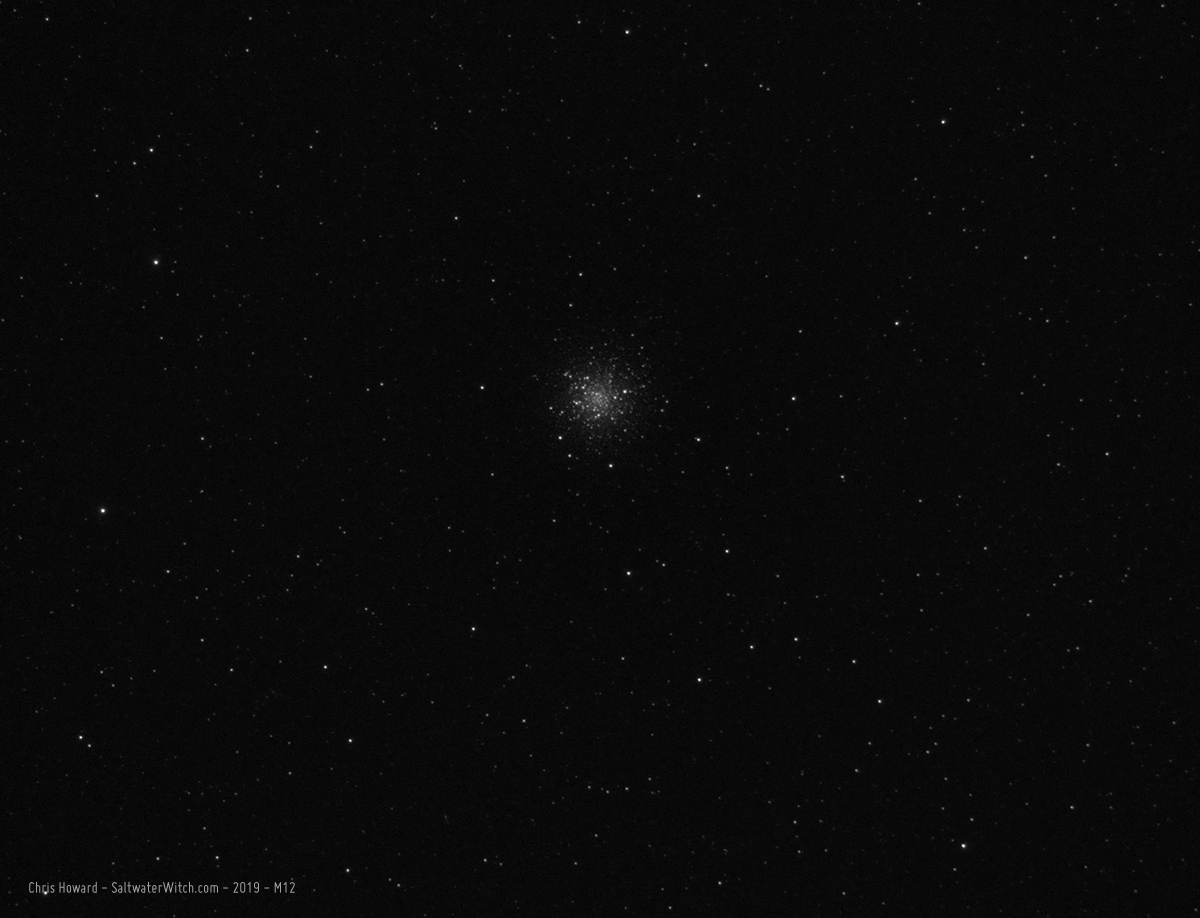
Posted May 23, 2019
Astro Session: July 9, 2018
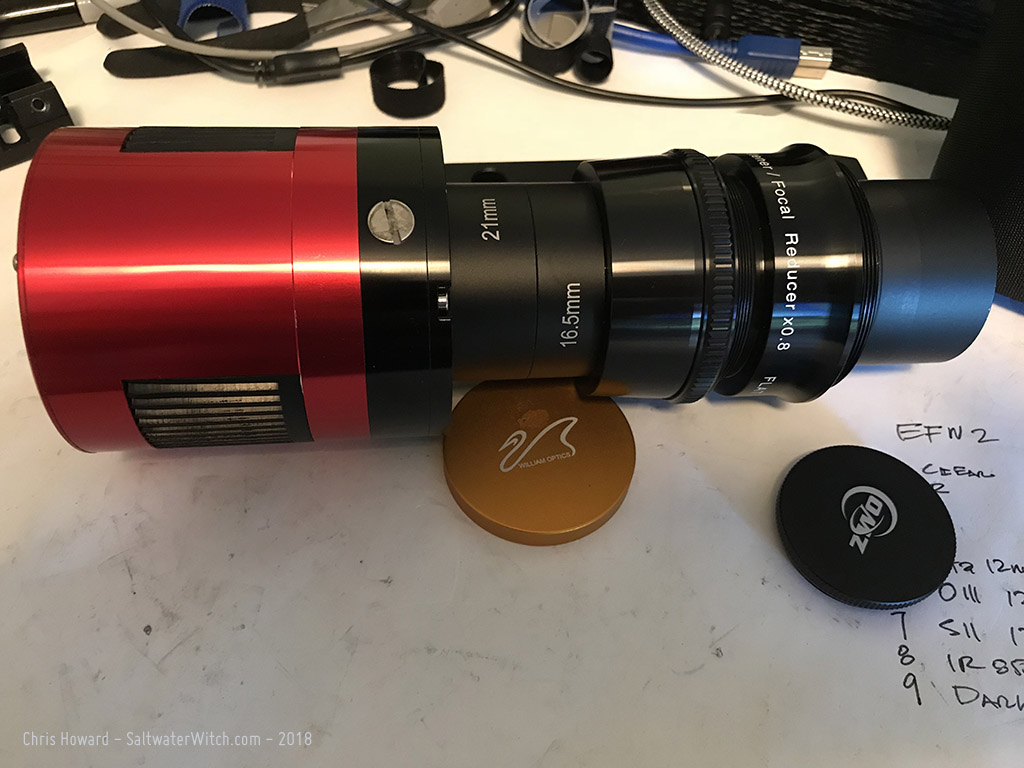 I recently bought the William Optics FLAT 6A II, and finally made it out under the stars to take some sub-exposures. I paired it with my GT-81 and ZWO ASI071MC color CMOS camera. The FLAT 6A II is a 0.8x reducer/field flattener; it's adjustable for different focal lengths, and so far, with my limited use, it appears to be quite a leap over the old William Optics F6-A I've used for a few years. The ASI071 has an APS-C sized sensor, and anyone with a large sensor astro camera or DSLR knows if you don't want field curvature with your refractor you need some sort of flattener. The FLAT6AII design makes it easy to dial in the correct distance for the scope you're using. The old reducer/flattener worked, but I had to test out a dozen different flattener to sensor distances, and still had to do some cropping and processing to fix the corners. This new FLAT 6AII provides a fairly flat field across the entire view. Equipment: William Optics GT-81 + FLAT 6A II 0.8x reducer f/4.7, ZWO ASI071MC-Cool color CMOS camera - gain 0 offset 8, ZWO ASI120MM-S Guide Cam + 130mm guide scope.
I recently bought the William Optics FLAT 6A II, and finally made it out under the stars to take some sub-exposures. I paired it with my GT-81 and ZWO ASI071MC color CMOS camera. The FLAT 6A II is a 0.8x reducer/field flattener; it's adjustable for different focal lengths, and so far, with my limited use, it appears to be quite a leap over the old William Optics F6-A I've used for a few years. The ASI071 has an APS-C sized sensor, and anyone with a large sensor astro camera or DSLR knows if you don't want field curvature with your refractor you need some sort of flattener. The FLAT6AII design makes it easy to dial in the correct distance for the scope you're using. The old reducer/flattener worked, but I had to test out a dozen different flattener to sensor distances, and still had to do some cropping and processing to fix the corners. This new FLAT 6AII provides a fairly flat field across the entire view. Equipment: William Optics GT-81 + FLAT 6A II 0.8x reducer f/4.7, ZWO ASI071MC-Cool color CMOS camera - gain 0 offset 8, ZWO ASI120MM-S Guide Cam + 130mm guide scope.
 Testing:
Testing:
With the GT81 and ASI071 I get a 3.54° x 2.35° field of view, and I can capture some big chunks of the night sky. Here are three from the last two nights: [1] the Pelican Nebula (IC 5070) and the edge of the North America Nebula (NGC7000) at the bottom, [2] IC 1396 nebula with the Elephant's Trunk at the top and the Garnet Star bottom left, and [3] M31, our galactic neighbor, the Andromeda Galaxy.
Pelican Nebula image info: ZWOASI071MC 39 x 240 second color subs stacked in DSS, processed in PSCC2018
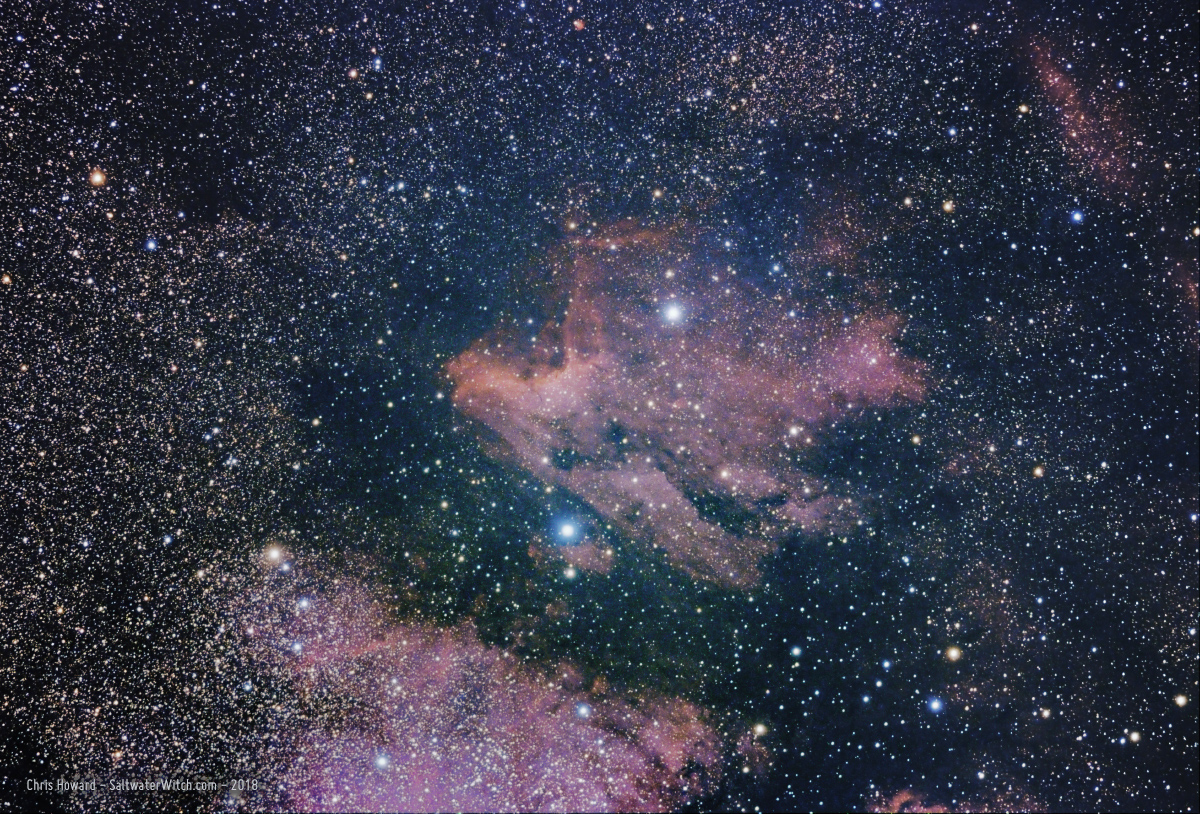
IC 1396 region image info: ZWOASI071MC 21 x 300 second color subs stacked in DSS, processed in PSCC2018
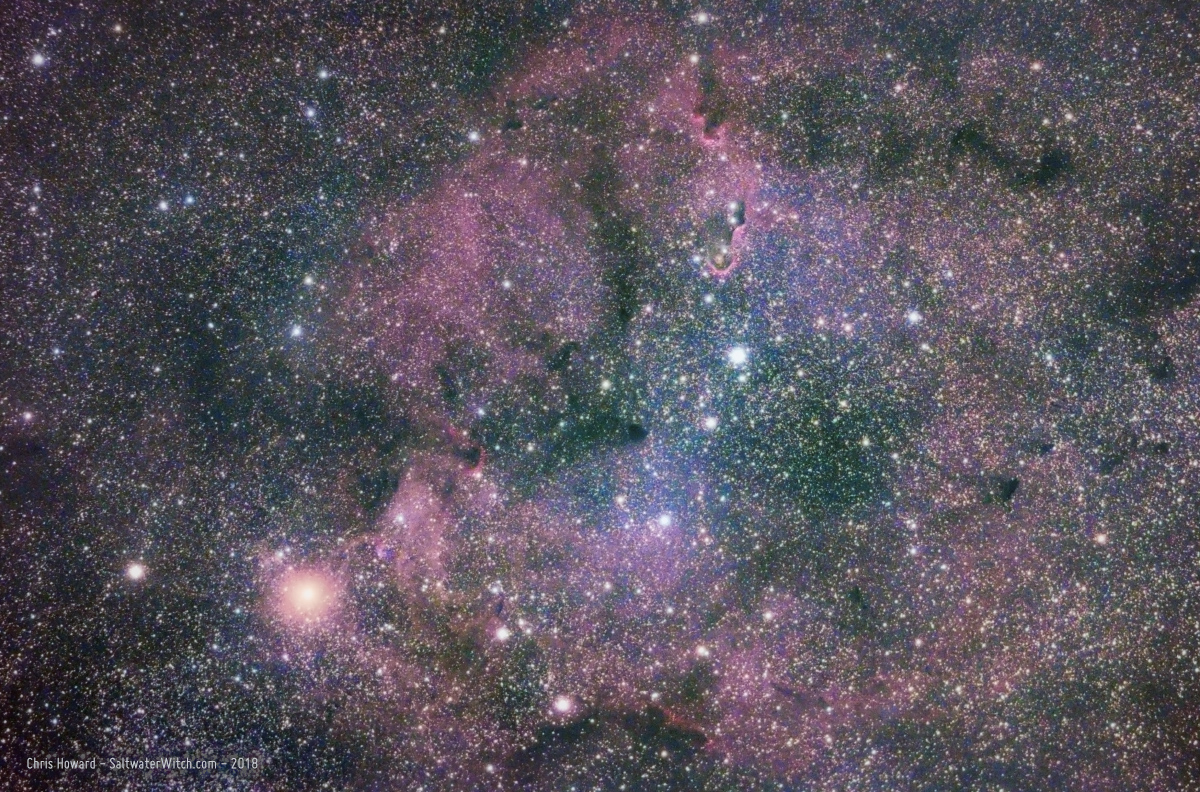
The Andromeda Galaxy. The last time I photographed Andromeda (M31) was 2015, maybe fall of 2014? It's been a while. I was using a DSLR--that was the only camera I had, and I had it on a terribly-used Celestron CG-5 equatorial mount with some aftermarket RA/DEC motors. By "terribly-used" I mean you could drive a truck through the gear backlash. Even so, I still managed to get some decent 30-second exposures of Andromeda, Orion Nebula, and other big bright targets in the sky. Well, I'm back with our galactic neighbor, and with much better gear: 192 x 120-second sub-exposures stacked in DSS, processed in PSCC2018, ZWO ASI071MC camera at -10C, William Optics GT81 APO, iOptron CEM25P EQ mount.
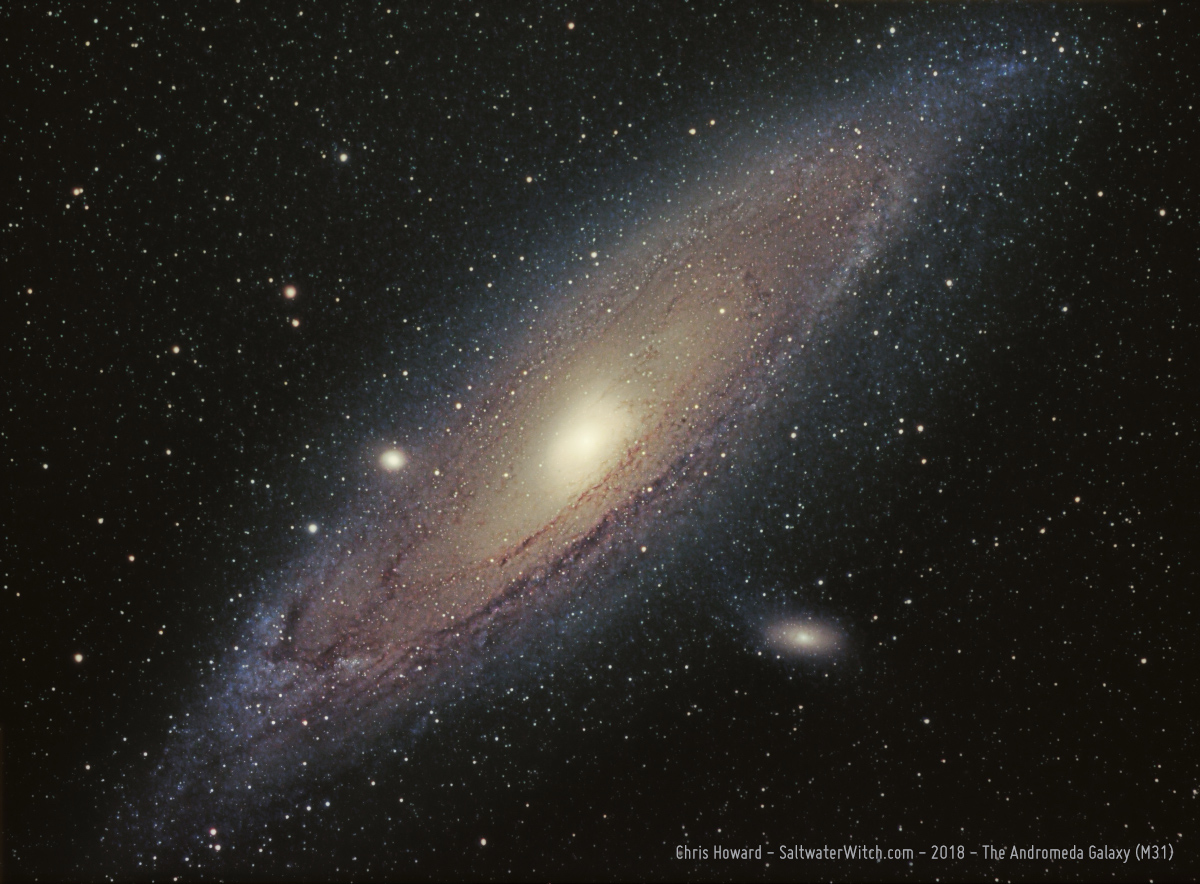
Posted July 9, 2018
Astro Session: July 7, 2018
Our galactic neighborhood, looking toward the center, with 13 stacked 15 second exposures, Nikon D750, Rokinon 10mm f/2.8 lens. What's crazy is this is with a decent DSLR camera, lens, a tripod, and some free image stacking software (DSS). I did the stretching in Photoshop CC--"stretching" is when you adjust contrast, intensity values, to bring out the features of whatever you're shooting--in this case the north end of the Milky Way Galaxy, our home. Let me point out some interesting features: starting at the left, that vivid red star is the "Garnet Star" (Mu Cephei), and that's right next to some cool nebulosity that includes the Elephant's Trunk Nebula (IC 1396), a little ways along, you see that blocky reddish region? That's the North America Nebula (NGC 7000) with the star Deneb (19th brightest star in the night sky). Deneb forms the northernmost (leftmost in this shot) point of the famous "Summer Triangle". The other two points are Vega, the 5th brightest star in the night sky (to the right and above the Milky Way core in this shot), and Altair (12th brightest) a little more to the right and below the Milky Way core. Moving along the galaxy to that bright region on the bottom side of the core, about halfway between Altair and the powerlines--if you really zoom in, you'll see the Wild Duck Cluster (M11). Now look just left of where the powerlines cross, those grayish-pink cloudy areas? That's where you will find the Eagle Nebula (Messier 16, NGC 6611) and the Swan Nebula (M17). That bright point of light in the middle of the powerlines is the planet Saturn, which is moving along the ecliptic and right now it's in a pretty good place for viewing. Just right of that are a few more cloudy areas. That's where you would look for the Lagoon Nebula (M8, NGC 6523) and Trifid Nebula (M20, NGC 6514). Somewhere along the Milky Way--this is where you will mostly likely find me focusing my telescope all the through the summer and fall. I almost see this shot as a map of places to visit from afar, and the cool thing is you really don't need to setup the astro gear for this. You can create your own galaxy map, as long as your camera can handle long exposures (not that long, only 15 seconds) and you have it on a tripod with a remote shutter control. And this is only part of the sky from where I'm standing on our little planet! Another way to put this image in perspective is here in the northern hemisphere, around 43° latitude, I don't have enough of a view south (blocked by hills and trees) to see Sagittarius A*, which marks the center of our galaxy, and this far north there's a sky full of other galaxies, a large section of our own galaxy, nebulae, and other deep space objects that I can't ever see from here--that I would have to travel below the equator to see. Some day!
